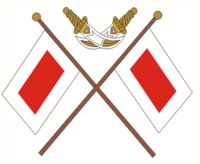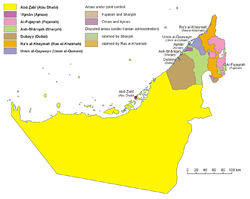Ras Al Khaimah
| Ras Al Khaimah إمارة رأس الخيمة Ra's al-Khaymah, Ras Al-Khaimah or RAK | |||
|---|---|---|---|
| Emirate | |||
| Emirate of Ras Al Khaimah | |||
|
| |||
| |||
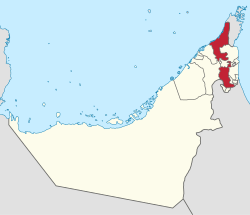 Location of Ras Al Khaimah in the UAE | |||
| Coordinates: 25°47′N 55°57′E / 25.783°N 55.950°ECoordinates: 25°47′N 55°57′E / 25.783°N 55.950°E | |||
| Country |
| ||
| Emirate |
| ||
| Government | |||
| • Type | Absolute monarchy | ||
| • Ruler | Saud bin Saqr al Qasimi | ||
| • Crown Prince | Mohammed bin Saud al Qasimi | ||
| Area | |||
| • Total | 2,486 km2 (960 sq mi) | ||
| Population (2008) | |||
| • Total | 263,217 | ||
Ras Al Khaimah (Arabic: رأس الخيمة; IPA: [raʔs alˈxajma]), historically known as Julfar, is one of the seven emirates that make up the United Arab Emirates (UAE). The capital city and home of most residents is also called Ras Al Khaimah, sometimes abbreviated as RAK city.[1]
Its name could be taken to mean "headland of the small huts", which can be attributed to the indigenous buildings that existed along the coast. The emirate is in the northern part of the UAE, bordering Oman's exclave of Musandam. It covers an area of 2,486 km2 (960 sq mi).
The emirate had a population of 210,063 at the 2005 Census, of which 41.82 percent or 87,848 were Emirati citizens. Latest estimates put the total population at between 250,000 and 300,000. Locals accounted for 97,529 in the population estimate for 2010.[2]
Its capital city RAK city has two main sections, Old Ras Al Khaimah and Nakheel, on either side of a creek. It is served by the Ras Al Khaimah International Airport. It consists of a northern part (where the city of Ras al-Khaimah is situated), and a large inland exclave in the south (near Hatta), and a few small islands in the Persian Gulf.[3] Ras Al Khaimah has the most fertile soil in the country, due to a larger share in rainfall and underground water streams from Omani mountains.[4]
History
Ras Al Khaimah has been the site of human habitation for several millennia and there are many historical and archaeological sites throughout the emirate - local sources cite 1,000[5] - dating from different time periods, including remnants of the Umm al-Nar Culture (3rd millennium BC).[6] Wadi Suq era graves found at Seih Al Harf in the Emirate in October 2012 briefly held up the construction of the northern spur of the arterial E611 road.[7]
According to Sheikh Sultan bin Muhammad Al-Qasimi, current ruler of Sharjah Emirate, the city of Ras Al Khaimah (which before was the capital of the state that is now Sharjah) was historically known as Julfar and was founded by Armenians who escaped Persia during the Mongol invasion.
Archaeological evidence has demonstrated that the settlement known as Julfar shifted location over time as harbour channels silted up. Excavations of a sizable tell, which revealed remnants of a Sassanid era fortification, indicate that early Julfar was located in the north of Ras Al Khaimah, not far from other sites of historical/archaeological interest such as 'Sheba's Palace' and the largest Umm al-Nar tombs found on the Arabian Peninsula.
There is considerable debate locally regarding the 18th-century charge of maritime piracy, attracting the British label 'The Pirate Coast' to the Eastern Gulf before a series of treaties in 1820, 1853 and, in 1892, the Perpetual Maritime Truce led to it being known as the 'Trucial Coast'.
In the early 18th century, the Al Qasimi dynasty established itself in Ras Al Khaimah and Sharjah on the Arabian Peninsula, growing to become a significant maritime force with holdings on both the Persian and Arabian coasts. In 1819, a British naval force was sent from Bombay in order to suppress alleged piracy - actions of the Al Qasimi fleet against British flagged shipping that affected trade routes in the Strait of Hormuz, along the Persian Gulf coast, and the Indian Ocean.[8]
In the Battle of Ras Al Khaimah of 1809, the Al Qasimi fleet was largely destroyed. The British operation continued to Linga on the Persian coast which was, like the Greater and Lesser Tunbs islands, administered by the Al Qasimi. The attack on Ras Al Khaimah resulted in the destruction of the tower of the 16th century Dhayah Fort whose remains can be seen at Rams in northern Ras Al Khaimah. In January 1820, the British imposed the General Maritime Treaty of 1820 signed by Sheikh Sultan Bin Saqr Al Qasimi who was reinstated by the British in Ras Al Khaimah after the deposition of Hasan Bin Rahma.[9] The treaty stipulated the end of piracy and slavery, and laid the foundation for the British protectorate over the Trucial States that lasted until December 1971. In 1869, Ras Al Khaimah became fully independent from neighbouring Sharjah. However, from September 1900 to 7 July 1921, it was re-incorporated into Sharjah; the last governor became its next independent ruler.
On 10 February 1972,[10] Ras Al Khaimah, under the leadership of Sheikh Saqr bin Mohammad al-Qasimi, joined the United Arab Emirates.
List of rulers
Its rulers were:
- 1708–1731: Sheikh Rahma Al Qasimi
- 1731–1747: Sheikh Matar bin Butti Al Qasimi
- 1747–1777: Sheikh Rashid bin Matar Al Qasimi[11]
- 1777–1803: Sheikh Saqr bin Rashid Al Qasimi
- 1803–1809: Sheikh Sultan Bin Saqr Al Qasimi (1st time)[12]
- 1809–1814: Sheikh Hasan bin `Ali Al Anezi
- 1814–1820: Sheikh Hassan bin Rahma. In 1820 removed as ruler of RAK by British, recognised as Sheikh of Khatt and Falna. Signed General Maritime Treaty of 1820.
- 1820–1866: Sheikh Sultan Bin Saqr Al Qasimi (2nd time). In 1820 shifted capital to Sharjah.
- 1866 – May 1867: Sheikh Ibrahim bin Sultan Al Qasimi. Ruler of RAK.
- May 1867 – 14 April 1868: Sheikh Khalid bin Sultan Al Qasimi (died 1868). Ruler of RAK.
- 14 April 1868 – 1869: Sheikh Salim bin Sultan Al Qasimi (18??–1919). Ruler of Sharjah and RAK.
- 1869 – August 1900: Sheikh Humaid bin Abdullah Al Qasimi (died 1900). Ruler of RAK.
- 1900 – 1914: Sheikh Saqr bin Khalid Al Qasimi
- 1914 –1921: Sheikh Khalid bin Ahmad Al Qasimi
- 10 July 1921 – Feb 1948: Sheikh Sultan bin Salim Al Qasimi
- 17 July 1948 – 27 October 2010: Sheikh Saqr bin Mohammad al-Qassimi (1918–2010)
- 27 October 2010 – current: Sheikh Saud bin Saqr al Qasimi[13]
- The appointed heir presumptive is currently Muhammad bin Saud al Qasimi, son of the current Ruler of the Emirate.
Population
In 1975, the total population of Ras Al Khaimah was 43,845 of which 29,613 were nationals and 14,232 were foreigners. This figure increased to 73,918 (39,148 locals; 34,770 foreigners) in 1980, 96,578 in 1985, 143,334 in 1995, and 210,063 in 2005. The current total population is estimated to be between 250,000 and 300,000 people, nationals and foreigners.[14]
Towns and settlements
Important towns, settlements and areas include:
- Al Jazirah Al Hamra – an old coastal town with numerous real estate projects and industrial zone
- Rams – a coastal town; in the past, a typical fishing and pearl-diving village
- Khawr Khuwayr – an industrial zone, with the largest port in Ras Al Khaimah and numerous companies such as a cement factory
- Diqdaqah – a village known for agriculture activities
- Khatt – a village surrounded by mountains, famous for its thermal springs and palm gardens
- Masafi – a town in the south, on the border with Fujairah; well known for drinking water
- Huwaylat – a central village in the south
- Al Dhait – the largest town in Ras Al Khaimah.
Climate
Ras Al Khaimah's desert climate (Köppen climate classification BWh) is hot and arid with very hot summers and mild winters. The average temperature is 18 to 25 °C (64 to 77 °F) in January and 29 to 43 °C (84 to 109 °F) in July. However, temperatures often reach 45 °C in the summer; the highest recorded temperature is 48.8 °C (119.8 °F). The humidity is usually high in the summer months. Rains and thunderstorms occur rarely, and only in winter. Snow has been reported in December 2004, January 2009 and February 2017[15] in the high mountains of Ras al-Khaimah. Temperatures as low as −5 °C (23 °F) have been measured at the peak of Jebel Jais.[16]
| Climate data for Ras al-Khaimah Airport | |||||||||||||
|---|---|---|---|---|---|---|---|---|---|---|---|---|---|
| Month | Jan | Feb | Mar | Apr | May | Jun | Jul | Aug | Sep | Oct | Nov | Dec | Year |
| Record high °C (°F) | 32.0 (89.6) |
33.4 (92.1) |
42.2 (108) |
42.8 (109) |
46.6 (115.9) |
48.1 (118.6) |
47.8 (118) |
47.2 (117) |
46.1 (115) |
41.6 (106.9) |
37.9 (100.2) |
32.3 (90.1) |
48.1 (118.6) |
| Average high °C (°F) | 24.8 (76.6) |
25.9 (78.6) |
29.5 (85.1) |
35.2 (95.4) |
39.3 (102.7) |
42.1 (107.8) |
42.7 (108.9) |
41.9 (107.4) |
40.1 (104.2) |
36.7 (98.1) |
31.4 (88.5) |
26.8 (80.2) |
34.7 (94.5) |
| Daily mean °C (°F) | 18.3 (64.9) |
19.4 (66.9) |
22.3 (72.1) |
26.8 (80.2) |
31.2 (88.2) |
33.6 (92.5) |
35.5 (95.9) |
35.0 (95) |
32.2 (90) |
28.4 (83.1) |
23.5 (74.3) |
20.3 (68.5) |
27.2 (81) |
| Average low °C (°F) | 11.8 (53.2) |
12.9 (55.2) |
15.5 (59.9) |
18.9 (66) |
22.6 (72.7) |
25.6 (78.1) |
28.5 (83.3) |
28.6 (83.5) |
24.7 (76.5) |
20.7 (69.3) |
16.6 (61.9) |
13.5 (56.3) |
20 (68) |
| Record low °C (°F) | 4.4 (39.9) |
4.6 (40.3) |
7.6 (45.7) |
11.0 (51.8) |
15.0 (59) |
18.7 (65.7) |
22.5 (72.5) |
22.4 (72.3) |
18.3 (64.9) |
11.8 (53.2) |
7.3 (45.1) |
5.2 (41.4) |
4.4 (39.9) |
| Average precipitation mm (inches) | 12.8 (0.504) |
35.7 (1.406) |
35.0 (1.378) |
12.5 (0.492) |
2.8 (0.11) |
0.0 (0) |
0.6 (0.024) |
0.3 (0.012) |
1.3 (0.051) |
6.4 (0.252) |
8.0 (0.315) |
17.4 (0.685) |
132.8 (5.229) |
| Average precipitation days (≥ 0.2 mm) | 1.7 | 3.3 | 4.7 | 0.9 | 0.2 | 0.0 | 0.1 | 0.2 | 0.1 | 0.1 | 0.7 | 2.3 | 14.3 |
| Average relative humidity (%) | 69 | 66 | 62 | 53 | 46 | 50 | 50 | 53 | 57 | 59 | 62 | 69 | 58 |
| Mean monthly sunshine hours | 238.7 | 218.4 | 238.7 | 285.0 | 344.1 | 327.0 | 303.0 | 310.0 | 300.0 | 303.8 | 279.0 | 235.6 | 3,383.3 |
| Source: NOAA [17] | |||||||||||||
Economy
Industries
As one of the non-oil producing emirates, Ras Al Khaimah has focused on developing its industrial sector. In 1920, Ras Al Khaimah was reportedly involved in iron ore extraction.[18]
Main economic sectors
- Real Estate – numerous residential areas, offices, commercial buildings are constructed in Ras Al Khaimah.
- Tourism – Ras Al Khaimah is becoming a new destination on tourist maps. Ras Al Khaimah is home to five star hotels and beach resorts including Hilton Hotels and Resorts, Rotana or Banyan Tree. It has a number of 4 and 3 star accommodations. In September 2010, first water park Ice Land was opened to offer leisure opportunity for both residents and visitors and more new tourism projects are under construction.
- Building materials – Ras Al Khaimah opened the UAE's first cement company in the early 1970s and is now the UAE's largest producer of cement. In the 1980s, the emirate formed Ras Al Khaimah Ceramics, which has become one of the world's largest ceramics producers.
- Manufacturing and High-Tech Industry – In the 1980s, the emirate formed Gulf Pharmaceutical Industries (Julphar), the Persian Gulf region's first pharmaceuticals company. Falcon Technologies International (FTI) represents high-tech industry and produces optical storage media (CDR,DVDR, BDR). In 2012, Innovative Composite Engineering was established in the Industrial Free-zone to manufacture high end composite products (aerospace, construction parts).[19]
- Service sector – recently growing sector with its prominent RAK Bank and RAK Insurance companies.
- Agriculture and Fisheries – in the past, these were the main economy sectors of Ras Al Khaimah. Nowadays they are still significant providing foodstuff not only for the Emirate but for the whole country.
Taxation and companies law
New legislation and regulations favour international investments. The combination of security and confidentiality is ensured to entrepreneurs. An international company may only have foreign customers and is not liable for paying local taxes. It can open a local bank account, make investments tax-free, and obtain mortgages for investing in UAE assets. Employment visas are available. When approved, this type of company can own property in UAE free-trade zones.
No income, sales, or wealth taxes are payable by individuals. No corporate taxes are charged. In addition, there are no exchange controls, no withholding nor import or export taxes.
Culture
The UAE culture mainly revolves around the religion of Islam and traditional Arab culture. The influence of Islamic and Arab culture on its architecture, music, attire, cuisine and lifestyle are very prominent as well. Five times every day, Muslims are called to prayer from the minarets of mosques which are scattered around the country. Since 2006, the weekend has been Friday-Saturday, as a compromise between Friday's holiness to Muslims and the Western weekend of Saturday-Sunday.[20] It should be noted however that a great majority of the population are non national citizens, coming from India, Pakistan, and a wide range of nations.
Community
The majority of mosques are Hanbali, Muwahhid Muslim or Salafi
Events
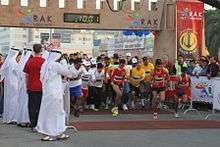
The annual Ras Al Khaimah Half Marathon, first held in 2007, resulted in a world record from Samuel Wanjiru in 2007 and the second fastest run of all-time from Patrick Makau Musyoki in 2009.[21]
The UAE Awafi Festival is an annual cultural and heritage festival held in the Ras Al Khaimah desert. It is a three-week event, held in December or January, one attraction being a sand dune race. There is a heritage village with traditional food and dance, as well as shops for food and souvenirs.
The Terry Fox Run RAK is a yearly charity run organized in Ras Al Khaimah to support cancer research in the UAE.[22] The first event was organized in 2010 (short movie from 1st RAKTFR event). Participation of this event has grown from hundreds to thousands since its inception.
Infrastructure
Transportation
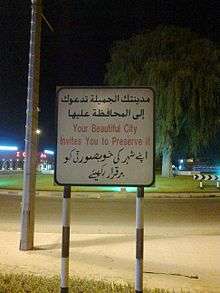
Within Ras Al Khaimah city, the main mode of public transport are metered taxis, with public buses operating on long-haul routes and catering mainly to smaller towns (e.g. Sha`am, Rams, and Al Jazirah Al Hamra). A local bus service operated by RAK Transport Authority provides infrequent connections between Nakheel, Al Hamra and the airport.[23]
Ras Al Khaimah is connected to the other emirates by taxis and buses which embark from the Bus Station located at RAK Transport Authority Headquarters near the new Ras Al Khaimah Police Headquarters and opposite the Cove Rotana hotel.
Three dual-carriageways link Ras Al Khaimah with the other emirates and beyond. One follows the coast with beaches on one side and stretches of desert on the other; the other, a new route, runs out towards the airport in the direction of Khatt, Masafi, Fujairah, Dhaid, and eventually Oman.
The Emirates Road (E311 Highway) from Ras Al Khaimah traverses the emirates of Umm Al Quwain, Ajman (for 60 km (37 mi) of its length) and Sharjah (for 71 km (44 mi) of its length) to finally end up in Dubai (for 87 km (54 mi) of its length). The highway allows journeys from Ras Al Khaimah to Dubai in under 45 minutes. The highway is being extended further till Saqr Port to allow direct flow of traffic from the southern emirates, the extension was scheduled to be completed by 2014. In spring 2013 work on the 32-kilometre (20 mi) RAK Ring Road which will bypass the city and connect the quarries and factories of the north coast with the 311 motorway was held up by a three-month rescue excavation after the discovery of megalithic tombs dating to the Wadi Suq period, from 2000 to 1600 BC.[24]
Saqr Port, located in the industrial area of Khawr Khuwayr, is the emirate's main port, providing bulk and container services. It has eight deep-water berths, each 200 m (660 ft) long, is dredged to 12.2 m (40 ft) and has two "ro-ro" ramps plus specialised berths for handling bulk cement and aggregate. Other services include ship-handling, crew changes, and 40,000 m2 (430,000 sq ft) of covered storage, together with a vast open storage area. It is also the closest port in the UAE to Bandar Abbas, Iran, but there is no shipping from Saqr port to Bandar Abbas.
Ras Al Khaimah International Airport offers cargo and passenger services to a variety of destinations covering the Middle East, North & East Africa, Central Asia and the Indian Subcontinent. It serves as a hub for low cost carrier Air Arabia.
On 17 February 2006, Space Adventures announced its plans to develop a $265 million commercial spaceport in Ras Al Khaimah for space tourism.[25] This plan has yet to be realized.
Landmarks
Notable landmarks in Ras Al Khaimah include:
- The National Museum of Ras Al Khaimah: housed in the former palace of the ruling Al Qasimi family, with exhibits on natural history, arts and crafts of previous centuries, and archaeology
- Dhayah Fort: the only surviving hilltop fort in the UAE[26]
- Sheba's Palace: ruins of a medieval palace
- Al Falayah: the former summer residence of the ruling Al Qawasim family
- Al Jazirah Al Hamra: an abandoned "ghost town" showing the preserved architecture of a 20th-century pearling port[27]
- The Old City and Souq: both traditional and modern shops as well as artisans' workshops
- Bab Al Bahr: Pyramid inspired buildings along Ras Al Khaimah's coastal line
- Waldorf Astoria - Ras Al Khaimah
- Bu Shaqq tower 25°01′N 55°47′E / 25.017°N 55.783°E [28]
- Al Hayl Fort: One of the robust forts that occupies an important strategic location and oversees a vast area, all leading to the road of Fujairah[29]
Dunes and landforms
- Al-Khushaym 25°26′N 55°58′E / 25.433°N 55.967°E[28]
- Bani Fasan 23°53′N 52°09′E / 23.883°N 52.150°E[28]
- Jabal Jais, on the city's outskirts
See also
References
- ↑ "People evacuated from flooded houses in Fujairah, Ras Al Khaimah". khaleejtimes.com. 2014-03-18. Retrieved 2018-09-21.
- ↑ "UAE National Bureau of Statistics: Population Estimates 2006-2010" (PDF). Uaestatistics.gov.ae. Archived from the original (PDF) on 2013-10-08. Retrieved 2013-09-16.
- ↑ UAE map
- ↑ "Agriculture - United Arab Emirates - export, crops, farming". www.nationsencyclopedia.com. Retrieved 17 June 2018.
- ↑ "RAK drives home its heritage credentials". The National. 29 October 2014. Retrieved 30 March 2015.
- ↑ "New archaeological site found in Ras Al Khaimah". GulfNews.com. 2013-02-11. Retrieved 2013-09-15.
- ↑ "Ancient graves unearthed in RAK". GulfNews.com. 2013-04-05. Retrieved 2013-09-15.
- ↑ 1939-, Sulṭān ibn Muḥammad al-Qāsimī, Ruler of Shāriqah, (1986). The myth of Arab piracy in the Gulf. London: Croom Helm. ISBN 0709921063. OCLC 12583612.
- ↑ The Gulf States: A Modern History - David Commins - ßĘČ Google. Books.google.com.bh. 2012-03-15. Retrieved 2013-09-15.
- ↑ Kourosh Ahmadi, Islands and International Politics in the Persian Gulf: The Abu Musa and Tunbs in Strategic Context (Routledge, 2008) p96
- ↑ Lorimer, John (1915). Gazetteer of the Persian Gulf. British Government, Bombay. p. 755.
- ↑ Lorimer, John (1915). Gazetteer of the Persian Gulf. British Government, Bombay. p. 641.
- ↑ "Saud is Ras Al Khaimah ruler as UAE mourns Shaikh Saqr". Gulf News. 2010-10-27.
- ↑ st1031120193 (2015-03-11). "RAS AL KHAIMAH". UAE : United Arab Emirates. Retrieved 2017-02-08.
- ↑ "Watch: Snowfall in UAE, temperature hits -2.2 degree". Khaleej Times. Retrieved 2017-02-05.
- ↑ "Heavy snowfall on Ras Al Khaimah's Jebel Jais mountain cluster". gulfnews.com. Retrieved 2015-08-16.
- ↑ "Ras Al Khaimah Climate Normals". National Oceanic and Atmospheric Administration. Retrieved December 19, 2012.
- ↑ Prothero, G.W. (1920). Arabia. London: H.M. Stationery Office. p. 98.
- ↑ "About Us". Composites.ae. Retrieved 2013-09-15.
- ↑ Jonathan Sheikh-Miller. "UAE Weekend Switchover". AMEinfo. Archived from the original on 12 February 2011. Retrieved 22 March 2010.
- ↑ Fairlie, Greg (2010-02-10). Fast times in store as a field of 10 sub-60 men announced for Ras al-Khaimah Half Marathon. IAAF. Retrieved on 2010-02-11.
- ↑ "Facebook". Facebook. Retrieved 2013-09-15.
- ↑ "Transport : Taxi/Bus". Government of Ras Al Khaimah.
- ↑ "Archaeologists make last ditch attempt to rescue remains of pre-historic tombs in RAK | The National". Thenational.ae. 2013-04-13. Retrieved 2013-09-15.
- ↑ "News : Press Releases :". Space Adventures. Archived from the original on 2013-11-12. Retrieved 2013-09-15.
- ↑ "Historic witness to RAK's defence". GulfNews.com. 2008-11-20. Retrieved 2013-09-15.
- ↑ Hawker, Ronald W. 'Tribe, house style, and the town layout of Jazirat al-Hamra, Ras al-Khaimah, UAE' in Proceedings of the Seminar for Arabian Studies, 2006
- 1 2 3 Gazetteer of the United Arab Emirates. Washington, D.C. : Defense Mapping Agency, 1987.
- ↑ "Al Hayl Fort". website. Fujairah Tourism & Antiquities Authority. Archived from the original on 2014-01-06.

